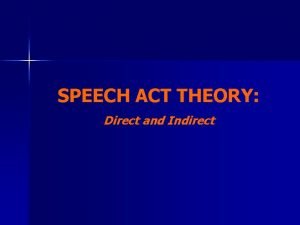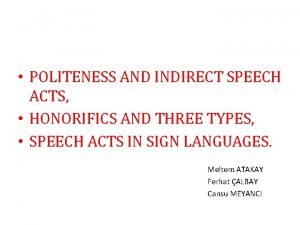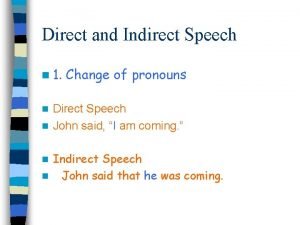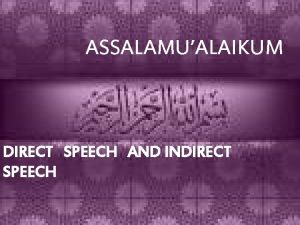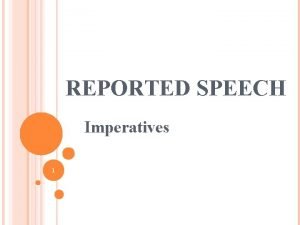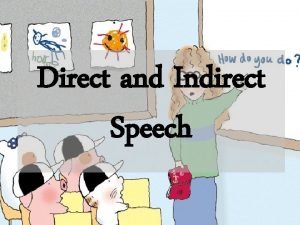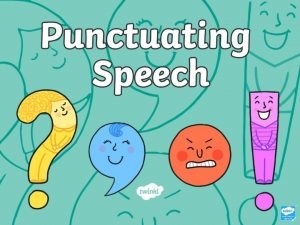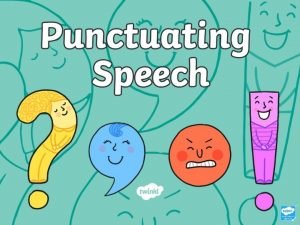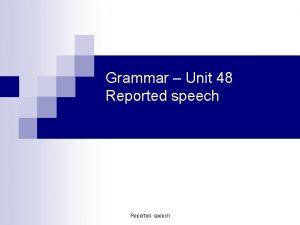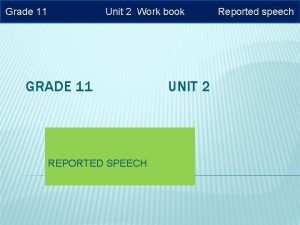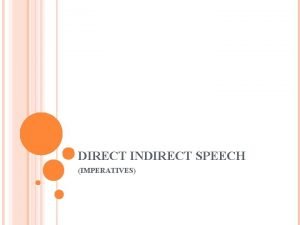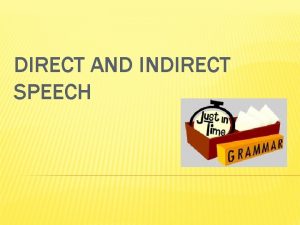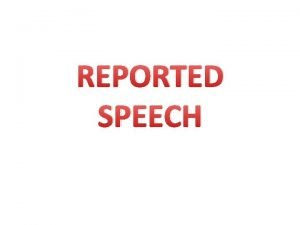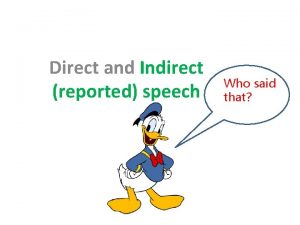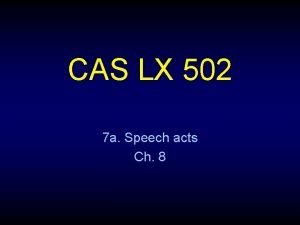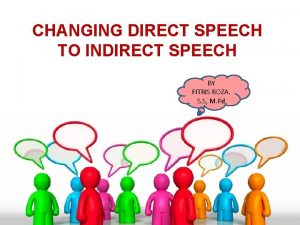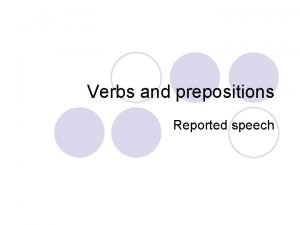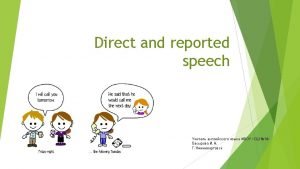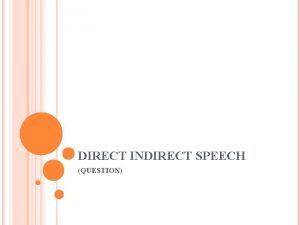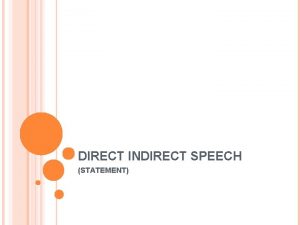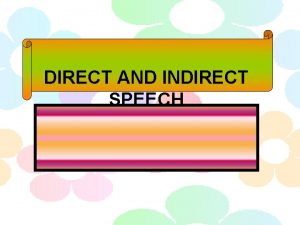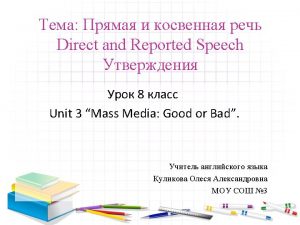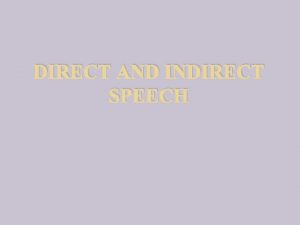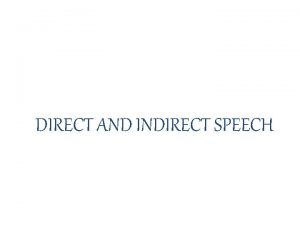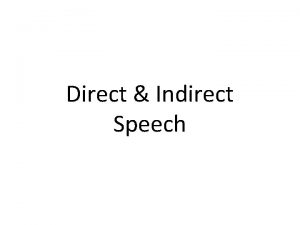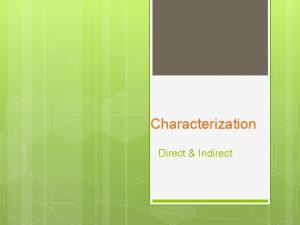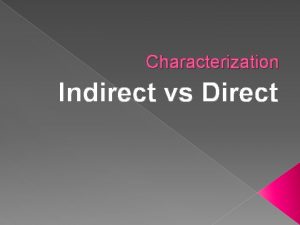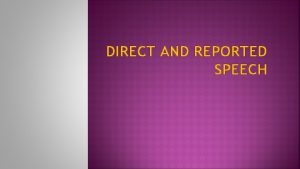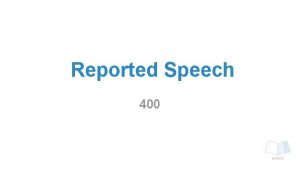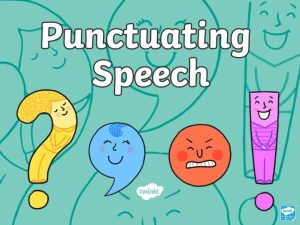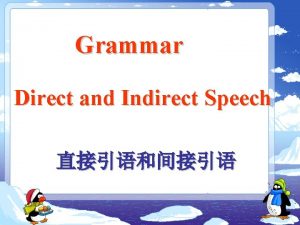Speech Acts Direct and indirect speech acts In























- Slides: 23

Speech Acts Direct and indirect speech acts

• In his famous work, How to do Things with Words 1953), J. L. Austin outlined his Theory of Speech Acts and the concept of performative language, in which to say something is to do something. – E. g. requests, ask questions, give orders, make promises, give thanks, offer apologies, and so on. • To make the statement “I promise that p” (in which p is the propositional content of the utterance) is to perform the act of promising

• Austin drew a distinction between utterances performing an action, performatives, and statements that convey information , i. e. constatives. • I apologize for the delay [either felicitous or infelicitous] • The window is open [either true or false]

Felicity conditions • For a speech act to be felicitous, it has to meet felicity conditions, i. e. expected or appropriate circumstances for a speech act to be recognized as intended • Several kinds of felicity conditions have been identified, including sincerity conditions (whether the speech act is being performed seriously and sincerely); – – promise: speaker genuinely intends to carry out the future action warning: speaker genuinely believes the future event will not have a beneficial effect preparatory conditions (whether the authority of the speaker and the circumstances of the speech act are appropriate) – I sentence you to six months in prison the performance will be infelicitous if the speaker is not a judge in a courtroom content conditions: e. g. for promises/warnings the content of the utterance must be about a future event If any of these conditions is lacking, then the hearers will deduce that they have to make a different interpretation of the speech act.

An action performed by producing an utterance consists of three related acts: • locutionary act: basic act of utterance, producing a meaningful linguistic expression – I've just made some coffee • illocutionary act: function/communicative force of the utterance (also called illocutionary force). – It can be a statement, offer, explanation etc. • perlocutionary act: intended effect of the action (also called perlocutionary effect)

And that is enough for today… • Locutionary act (and that is enough for today) • Illocutionary act ( students make preparations to quit the room) • Perloctionary act (you realise that a change has occurred)

• the same locutionary act can count as different illocutionary forces I'll see you later can be a prediction, promise or warning • Only the context can clarify its illocutionary force

Utterance: The tea is really cold! • Situation A: On a wintry day, the speaker reaches for a cup of tea, believing that it has been freshly made, takes a sip, and produces the utterance – > complaint • Situation B: On a really hot summer's day the speaker is being given a glass of iced tea, takes a sip, and produces the utterance – > praise

• Austin maintained that once “we realize that we have to study is not the sentence but the issuing of an utterance in a speech situation, there can hardly be any longer a possibility of not seeing that stating is performing an act”. • This conclusion expresses his belief that studying words or sentences (locutionary acts) outside of a social context tells us little about communication (illocutionary acts) or its effect on an audience (perlocutionary acts).

• John Searle, who continued Austin’s theory, claims the illocutionary act is “the minimal complete unit of human linguistic communication. Whenever we talk or write to each other, we are performing illocutionary acts”.

Performative verbs • In some utterances the verb explicitly indicates the illocutionary Force. Such verbs are called performative verbs • I promise/warn you that. . . , I apologise… I promise…. • • • they are not always made this explicit in conversation A: Can I talk to Mary? B: No, she's not here. A: I'm asking you - can I talk to her? B: And I'm telling you - She is not here!!!! - most of the time there is no performative verb mentioned

Explict vs implicit performatives • Explicit performatives are performative utterances that contain a performative verb that makes explicit what kind of act is being performed. I promise to come to your talk tomorrow afternoon. • implicit performatives are performative utterances in which there is no such verb. The only way to understand that this is a performative utterance is by considering the real intention behind that utterance. Here the context plays an important role. I’ll come to your talk tomorrow afternoon. (A promise? A threat)

Common explicit performatives • • • apology, promise, agreement acceptance advice suggestion warning requests betting to second to vote to abstain

Classification of speech acts (Searle) • DECLARATIONS: - speech acts that change the world by being uttered. The speaker has to have a special institutional role, in a specific situation – Priest: I now pronounce you husband wife – Referee: You're out – Jury Foreman: We find the defendant guilty • REPRESENTATIVES: speech acts that state what the speaker believes to be the case or not (statements of fact, assertions, conclusions and descriptions are all examples of the speaker representing the world as he/she believes it is) – The earth is flat (I hereby affirm that…) – Chomsky didn't write about peanuts – It was a warm sunny day, I think. the speaker is committed in varying degrees to the truth of a proposition: e. g. ‘affirm’, ‘believe, ’ ‘conclude’, ‘report’;

• DIRECTIVES. The speaker tries to get the hearer to do something (commands, orders, requests, suggestions…) – Gimme a cup of coffe. Make it black – Could you lend me a pen, please? – Don't touch that • COMMISSIVES: - speech acts that speakers use to commit themselves to some future action (promises, threats, refusals, pledges) – I'll be back – I'm going to get it right next time – We will not do that • EXPRESSIVES: the speaker expresses an attitude about a state of affairs (e. g. , ‘apologise’, ‘deplore’, ‘thank’, ‘welcome’) – Well done, Elisabeth!

Indirect Speech Acts • For many reasons, for example we don’t wish to impose – we may ask for something to be done indirectly. ‘Can you pass the salt’ is not really a question, but a directive; and answer of ‘yes’, without an attempt to pass it would be totally inappropriate.

Sentence type and illocutionary force • The three basic sentence types (declarative, interrogative, imperative) are typically associated with the three basic illocutionary forces: • Declarative: asserting/ stating; • Interrogative: asking/questioning; • imperative: ordering/requesting.

Direct vs indirect speech acts • Direct Speech Act: Whenever there is a direct relationship between a structure and a function – You wear a seat belt. (declarative) – Do you wear a seat belt? (interrogative) – Wear a seat belt! (imperative) • Indirect Speech Act: if the relationship between structure and function is indirect, e. g. a declarative used to make a request – “It's cold outside” can be interpreted as – a request to close the door (indirect speech act), or – I hereby tell you about the weather (direct speech act)

direct vs indirect speech acts • explicit performatives which happen to be in the declarative form, are also taken to be direct speech acts, because they have their illocutionary force explicitly named I suggest following his advice (declarative) Normally a declarative sentence uttered to perform a directive speech act would qualify as an indirect speech act, but in this case the explicit performative makes it a direct speech act.

• Example: Speaker wants hearer not to stand in front of the TV – Move out of the way! (Imperative -> direct speech act) – Do you have to stand in front of the TV? (Interrogative -> indirect speech act) – You're standing in front of the TV (Declarative -> indirect speech act)

Gradation of Indirect Speech Act Shut the door! I’d be grateful, if you’d shut the door. Could you shut the door? It’d help to have the door shut. It’s getting cold in here. Shall we keep out the draught? • Now, Jane, what have you forgotten to do? Brrr! • • •

Speech Acts in Use Consider the following cartoon and analyze Wally's answer on the basis of the distinction made between direct and indirect speech acts.

• Wally misunderstands the instructor’s indirect request for action (Who wants to share an opinion on why mouse training is important? ) as an information question.
 Direct or indirect speech act
Direct or indirect speech act Honorofics
Honorofics Example direct and indirect speech
Example direct and indirect speech Direct and indirect speech wh questions exercises
Direct and indirect speech wh questions exercises We in indirect speech
We in indirect speech Direct to indirect speech
Direct to indirect speech Advice in reported speech
Advice in reported speech Learning outcomes of direct and indirect speech
Learning outcomes of direct and indirect speech Reported speech words
Reported speech words Split direct speech
Split direct speech Inverted commas
Inverted commas Learning objectives of direct and indirect speech
Learning objectives of direct and indirect speech Speech grade 11
Speech grade 11 Direct imperative
Direct imperative Imperative direct and indirect speech
Imperative direct and indirect speech Imperative sentence direct to indirect
Imperative sentence direct to indirect Reported speech definition
Reported speech definition Reported statements: present simple
Reported statements: present simple Direct and indirect speech rules
Direct and indirect speech rules Indirect speech acts
Indirect speech acts Direct vs indirect speech
Direct vs indirect speech Direct versus indirect speech
Direct versus indirect speech Match the verbs and prepositions from
Match the verbs and prepositions from Present simple
Present simple
